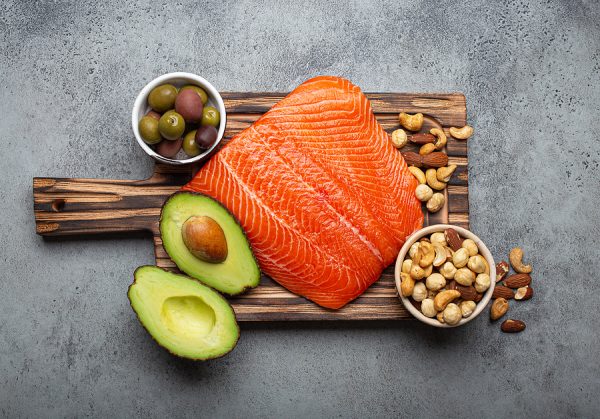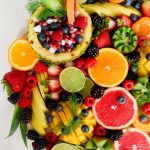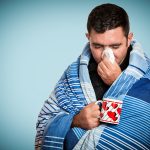Some people avoid fatty foods altogether. Other people can’t seem to stop eating them. And both of these scenarios are a problem.
First of all, your body needs healthy fats. You can’t absorb fat-soluble vitamins like A, D, E and K if you don’t eat any fatty foods. These nutrients are absolutely essential for brain function, hormone production, energy levels and the health of your skin, bones and eyes.
Plus, an adequate intake of healthy fats helps keep you feeling full longer, keeps your blood sugar steady between meals and is associated with healthy weight.
Still, you can get too much of a good thing.
Excessive intake of fatty foods, especially foods that contain unhealthy fats, can have a very negative effect on your health. Steadily eating a high-fat diet is associated with obesity, heart disease and certain types of cancer.
I think part of the problem here is that many people don’t realize how much fat they eat, or the quality of the fatty foods they are eating. In fact, some of the top sources of fat in the American diet are things like sausage, hot dogs, bacon, burgers, fried chicken, pizza, cheese, grain-based desserts, chips and fried potatoes.
These aren’t the healthiest sources of fats.
Even worse, these foods are considered hyperpalatable. The mix of fat with sodium or sugar make them highly palatable. The more of them you eat, the more of them you want! That’s how and why they’re engineered, to find the “bliss point” and addicting you to them.
Plus, animal studies reveal that prolonged exposure to a high fat diet disrupts the signaling pathways between the brain and the gut that regulates calorie consumption. So the brain’s ability to regulate calorie intake goes awry. Unhealthy fats as well cause a shift in the gut’s microbiome towards a profound dysbiotic, inflammatory profile moving through a now “leaky gut” into your circulation setting the stage for a host of chronic degenerative diseases.
Where to Find Healthy Fats
If you’re loading up on unhealthy fats from processed foods, commercial meats and dairy products, processed vegetable oils, fried foods, deli sandwiches and other less-than-healthy fats, it’s going to show up on your waistline… and in your health.
When you replace those unhealthy fats with ones that are good for you, they not only improve your gut health, general health and brain function, but also encourage weight loss.
Organic, plant-based fats are my top choice. This includes foods like avocados, nuts, seeds, coconuts and olives. I especially like Castelvetrano olives. I get them from Whole Foods (or better yet Coscto if they become part of your daily diet) and like to eat about 12 each day. They are packed with delicious olive oil and fiber.
For cooking and drizzling oils, olive or avocado oils are great choices. Even though other oils – such as corn oil and sunflower oil – are “plant-based,” they have a bad ratio of omega-6 to omega-3 fatty acids. This is a big problem, because omega-6 fatty acids promote inflammation.
You can get healthy animal fat from grass-fed beef. These animals are eating grass, which promotes a healthy balance of omega-3 fatty acids in their final meat products. The commercial cows who grow up eating corn are going to produce meat with a higher quantity of inflammatory omega-6 fatty acids. Plus, the corn they are fed is the cheap GMO corn.
And, of course, you can get plenty of healthy, anti-inflammatory omega-3s from wild caught fish. You can keep mercury exposure to a minimum by avoiding deepwater fish and sticking with ones that are lower on the food chain. This includes salmon, herring, sardines, trout and flounder. I especially like wild king salmon. They eat primarily algae, seaweed and smaller fish, so there is less mercury in their flesh.
It’s a Balancing Act
For optimal health, at least 25% of your calories should come from fat, and should not exceed 35%. The best time of day to get them is at breakfast since the fats will provide you with a steady source of energy to fuel your activities throughout the day.
Plus, when healthy fats are consumed early in the day, there is plenty of time to burn them off so they don’t end up getting stored as excess fat in your body.
Just remember to watch out for hyperpalatable fatty foods that can drive you to overconsume fats, and focus on plant-based sources!
SOURCES:
Bush NC, Resuehr HES, Goree LL, Locher JL, Bray MS, Soleymani T, Gower BA. A High-Fat Compared with a High-Carbohydrate Breakfast Enhances 24-Hour Fat Oxidation in Older Adults. J Nutr. 2018 Feb 1;148(2):220-226.
Park S, Ahn J, Lee BK. Very-low-fat diets may be associated with increased risk of metabolic syndrome in the adult population. Clin Nutr. 2016 Oct;35(5):1159-67.
Bhandari P, Sapra A. Low Fat Diet. [Updated 2022 Feb 10]. In: StatPearls [Internet]. Treasure Island (FL): StatPearls Publishing; 2022 Jan.
Liu AG, Ford NA, Hu FB, Zelman KM, Mozaffarian D, Kris-Etherton PM. A healthy approach to dietary fats: understanding the science and taking action to reduce consumer confusion. Nutr J. 2017 Aug 30;16(1):53.
Fazzino TL, Rohde K, Sullivan DK. Hyper-Palatable Foods: Development of a Quantitative Definition and Application to the US Food System Database. Obesity (Silver Spring). 2019 Nov;27(11):1761-1768.
Clyburn C, Carson KE, Smith CR, Travagli RA, Browning KN. Brainstem astrocytes control homeostatic regulation of caloric intake. J Physiol. 2023 Feb;601(4):801-829. Daley CA, Abbott A, Doyle PS, Nader GA, Larson S. A review of fatty acid profiles and antioxidant content in grass-fed and grain-fed beef. Nutr J. 2010 Mar 10;9:10.




